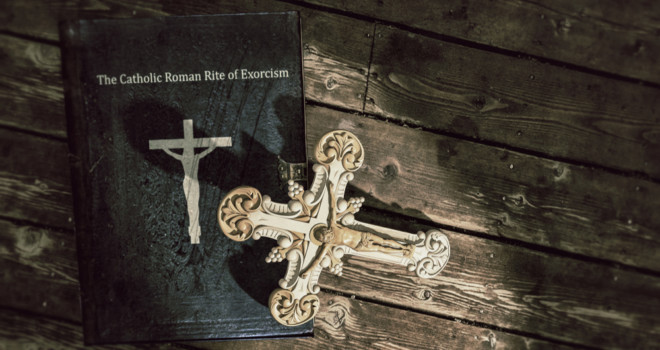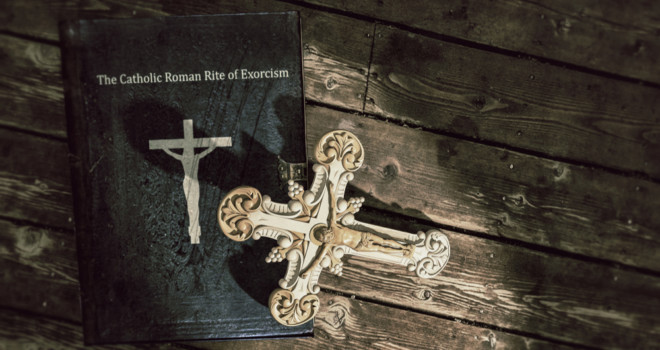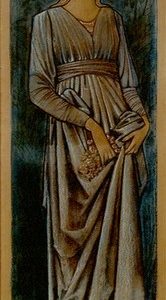The extraordinary action of the Devil
Satan’s other action in this world is extraordinary action, which God permits in some cases for reasons known only to Him. The Gospel speaks clearly of the character of a diabolical presence in man, who becomes like a “house” that has been usurped by an enemy and taken over. (Mark 3:22–27 mentions exorcisms worked by Jesus.) Extraordinary diabolical action is manifested in various forms that bear the names of vexation, obsession, possession, and infestation.
Diabolical vexation
Diabolical vexations that appear as physical attacks on a person are cuts, burns, scratches, punctures, writing on the skin, bites, beatings, blows that leave bruises, swellings, bloody sores, broken bones, incisions on the skin that spell words or form signs that persist for a certain time and then disappear, and illnesses with unknown causes and unknown cures. Obstacles also occur in the workplace and among affective relationships without logical explanation.
In the lives of the saints, other, even more serious, forms of vexations have been noted. Some of the saints have been the targets of stones, excrement, and feces that seemed to have come out of nowhere. Others have been hurled from their beds or down the stairs, tossed in the air or thrown down to the floor or against a wall, or dragged by the hair by an invisible hand; others have been taken from where they were and transported long distances.
In some cases, especially when the demon attacks physically, discernment is extremely easy. In these forms of vexation, the person attacked does not always manifest a repugnance toward the sacred or toward God. We have seen an example of this in the life of St. Pio of Pietrelcina and in so many other saints who have been subjected to physical vexations.
Evaluation by the priest exorcist is particularly challenging. He must listen to and evaluate persons tormented by certain symptoms or who are worn down by a chain reaction of negative events, such as misfortunes, failures, or physical illnesses, and are convinced that they need the exorcist priest. In these cases, the exorcist can assume that there is extraordinary demonic action if he can ascertain a connection between the possible effects previously described and an unexplainable aversion toward God, prayer, and the sacred.
If, together with the intensification of blessings and prayers of liberation, one sees a significant reduction of such phenomena, then one can suspect that their origin is in the extraordinary action of the devil.
Diabolical obsession
There are demonic assaults that, although they do not block the person’s intellectual powers and free will, succeed in inserting thoughts or obsessive images into the mind (the imagination and the memory) that the victim is not able to expel. In these cases, the person feels tormented by a fixed idea that he knows is foreign to him and seeks to find a way to reject it. But it is so deeply imprinted in his mind and spirit that it seems to be really his.
Obsessions can take on diverse forms, levels, and intensities and finally completely dominate the mind of the person. In that case, they become very strong and prolonged. To avoid confusing them with psychiatric pathologies, some exorcists prefer to define them with the term mental or psychic demonic vexations or interior demonic vexations; others prefer the term personal demonic infestations. Nevertheless, it is possible that the action of the Devil and a real psychic illness are present contemporaneously.
Given their similarity to psychiatric illnesses, the detection of diabolical obsessions is not always easy. The majority of these cases are pathological. There are some, however, that although manifesting themselves as symptoms similar to a psychiatric pathology, have their origin in an extraordinary action of the Devil.
Physical diabolical vexations and possessions usually are easily identifiable by their external signs. To arrive at concrete conclusions, each case must be examined individually. As previously mentioned, a significant sign of the origin of an obsession is the presence of a block, partial or total, toward prayer, or an unmotivated hatred toward everything that is sacred or has a reference toward the sacred.
But it is not always like this. At times persons who pray and regularly receive the sacraments (and do not present the above-mentioned symptoms and attitudes) can be subjected to obsessive forms of evil origins.
We see it in the lives of the saints when they are obsessed by the thought or sensation of being damned. Therefore, it is necessary to realize that there are situations in which it is possible to make a discernment of an obsession of the extraordinary action of the Devil by observing the efficacy or nonefficacy of the blessings and prayers of liberation.
Diabolical possession
Possession is not a splitting of the personality. Rather, it involves a temporary displacement of the person, during which a brutal and violent demonic spirit takes control. Acting from within the body, the demon makes the helpless victim speak and act as he wishes: such a phenomenon can be defined as the moment of crisis.
The Devil dominates the body of the person in order to annul his faculties of self-determination and control. The presence of the demon in the human body neutralizes the person’s ability to direct himself, so that he becomes a blind, docile instrument that is fatally obedient to a perverse and despotic power.
Thus, there are two components to the diabolical possession of a human body: the presence of the demon in the body and the exercise of his power. As such, the person possessed could be moved to another place, raised up, or temporarily changed physically.
During the crises, the person can be conscious, semiconscious, or in a total trance. In the exorcistic rite of 1952, the phenomena that accompany the possession are described as the speaking of a language completely unknown, possessing superhuman strength, bodily levitation, a change in physical features or characteristics, alteration of the voice, furious reactions before sacred objects, convulsions, loud cries, blasphemies, and the knowledge of things regarding the occult. Periods of calm can alternate with periods of crisis. The latter generally occur before sacred objects.
Prudence is necessary in determining the actuality of a possession. The possessed person is not responsible for acts committed while he is under diabolical influences. Possession is Satan’s supreme act of power, which he employs to demonstrate his superiority over man and his rebellion against God.
Regarding cases of persons who simultaneously manifest psychiatric disturbances and extraordinary phenomena, human deliberation does not have sufficient resources to justify a priori the exclusion of a probable demonic possession. Therefore, it is necessary to conduct a careful interdisciplinary examination that includes specialists in both the medical and spiritual fields. In this situation, the exorcist — assisted by medical specialists — determines the real causes and various components of the person’s illness.
In the Gospel, some cases of possession are clearly described: the mute demoniac (Matt. 9:32–33); the blind, mute demoniac who gives origin to the controversy with the Pharisees (Matt. 12:22–32; Mark 3:20–30; Luke 11:14–26); and Mary Magdalene (Mark 16:9; Luke 8:2). Four cases are described in detail: the demoniac of Capernaum (Mark 1:21–28; Luke 4:31–37); the demoniacs of Gerasa (Matt. 8:28–34; Mark 5:1–20; Luke 8:26– 29); the daughter of the Canaanite woman (Matt. 15:21–28; Mark 7:24–30); and the epileptic child (Matt. 17:14–20; Mark 9:14–28; Luke 9:37–43).
In these situations, Jesus reveals the motive for His presence in the history of men: to bring about the salvation and the liberation of man from the forces of the Evil One. He makes the Apostles and all the believers in Him who work in His name (Mark 16:17) collaborators in His work of salvation, conferring on them the power of crushing demons (Matt. 10:1–8; Mark 3:14–15; 6:7; Luke 9:1; 10:17–20).
In tormenting humans whom he hates, the Devil can feel solely a very wretched type of satisfaction because it does not diminish his torments, nor does God permit him to destroy man.
One cannot speak of a predisposition to possession, physical, psychic, or moral. Obstinate sinners are already victims of the Devil and they have no need of particular influences, whereas, once possessed, they would not voluntarily offend the Lord.
Vexation and possession are not per se a moral evil; rather, they are physical evils that God also permits for the good of the person. Some theologians point out the reasons for that divine permission: (1) for an increase in God’s glory (in this way God manifests His love and His attributes); (2) in order to manifest a truth of the Catholic religion, which is endowed with a special divine power; (3) for the spiritual profit of the upright; (4) as beneficial teachings for man; and (5) as proof for the conversion of sinners.
Diabolical infestation of a locality
The extraordinary action of the Devil that causes disturbances and nuisances in places, houses, and objects is called diabolical infestation in a locality. It also includes diabolical action on animals, which, in the last analysis is directed at man. The manifestations of such action are unexplainable noises, apparitions of objects or changes of their location, music or odd noises, phosphorescence (emission of light without any perceptible heat), odors, lights, animals that react as if they have seen someone or that are in an excited state, shadows, silhouettes, faces, and so forth.
Disturbances caused by these demonic interventions are carried out with noises or blows on the roof, pavement, walls, doors, windows, or furniture; showers of hailstones that fall as from nowhere on the roof or even in the house; noises of invisible steps, fireworks, or explosives; the clanging of chains and irons; mysterious voices, cries, laughs, or uproars; invisible bells that clamor; the disappearance of objects that are never found again or are found in the most unusual places in the house; pictures that are detached from the walls and fall without a comprehensible reason; underwear, sheets, blankets, and chairs that levitate in the air; animals (such as ravens, bats, reptiles, owls, dogs, or cats) that suddenly appear and soon vanish; sudden, intense, and untraceable burnt odors of excrement, sulfur, rotting flesh, or incense; and so forth.
If, after a vigorous inquiry, natural causes are excluded, prayers, blessings, and celebrations of Masses (authorized by the bishop) are offered in that place. If that leads to a disappearance of the phenomena or a significant lessening of them, one can suspect that their origin was truly an extraordinary action of the demon.
At times infestations of such phenomena disappear, not because of blessings and exorcisms, but rather because their demonic origin is in someone who lives in that place and the phenomena are tied to that person. Once that person changes habitation, those who continue to live there no longer notice anything and live peacefully. The unexplainable phenomena follow the afflicted party to his new domicile.
✠
Editor’s note: This article is adapted from Fr. Paolo Carlin’s An Exorcist Explains How to Heal the Possessed (And Help Souls Suffering Spiritual Crises). It is available from your local Catholic bookstore or online through Sophia Institute Press.
We also recommend the articles “An Exorcist on What Happens During an Exorcism” and “Exorcist Diary: The Work of the Angels in the Ministry of Exorcism.”













